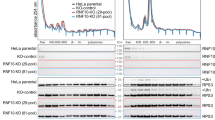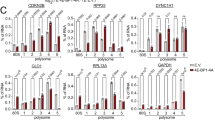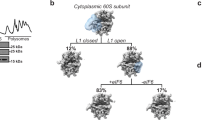Abstract
During apoptosis and under conditions of cellular stress, several signaling pathways promote inhibition of cap-dependent translation while allowing continued translation of specific messenger RNAs encoding regulatory and stress-response proteins. We report here that the apoptotic regulator Reaper inhibits protein synthesis by binding directly to the 40S ribosomal subunit. This interaction does not affect either ribosomal association of initiation factors or formation of 43S or 48S complexes. Rather, it interferes with late initiation events upstream of 60S subunit joining, apparently modulating start-codon recognition during scanning. CrPV IRES–driven translation, involving direct ribosomal recruitment to the start site, is relatively insensitive to Reaper. Thus, Reaper is the first known cellular ribosomal binding factor with the potential to allow selective translation of mRNAs initiating at alternative start codons or from certain IRES elements. This function of Reaper may modulate gene expression programs to affect cell fate.
This is a preview of subscription content, access via your institution
Access options
Subscribe to this journal
Receive 12 print issues and online access
$209.00 per year
only $17.42 per issue
Buy this article
- Purchase on SpringerLink
- Instant access to full article PDF
Prices may be subject to local taxes which are calculated during checkout







Similar content being viewed by others
References
Holcik, M. & Sonenberg, N. Translational control in stress and apoptosis. Nat. Rev. Mol. Cell Biol. 6, 318–327 (2005).
Marash, L. & Kimchi, A. DAP5 and IRES-mediated translation during programmed cell death. Cell Death Differ. 12, 554–562 (2005).
Bushell, M. et al. Cleavage of polypeptide chain initiation factor eIF4GI during apoptosis in lymphoma cells: characterisation of an internal fragment generated by caspase-3-mediated cleavage. Cell Death Differ. 7, 628–636 (2000).
Marissen, W.E., Gradi, A., Sonenberg, N. & Lloyd, R.E. Cleavage of eukaryotic translation initiation factor 4GII correlates with translation inhibition during apoptosis. Cell Death Differ. 7, 1234–1243 (2000).
Sonenberg, N. & Dever, T.E. Eukaryotic translation initiation factors and regulators. Curr. Opin. Struct. Biol. 13, 56–63 (2003).
Qin, X. & Sarnow, P. Preferential translation of internal ribosome entry site-containing mRNAs during the mitotic cycle in mammalian cells. J. Biol. Chem. 279, 13721–13728 (2004).
Hellen, C.U. & Sarnow, P. Internal ribosome entry sites in eukaryotic mRNA molecules. Genes Dev. 15, 1593–1612 (2001).
Holcik, M. Targeting translation for treatment of cancer–a novel role for IRES? Curr. Cancer Drug Targets 4, 299–311 (2004).
Hinnebusch, A.G. & Natarajan, K. Gcn4p, a master regulator of gene expression, is controlled at multiple levels by diverse signals of starvation and stress. Eukaryot. Cell 1, 22–32 (2002).
Clemens, M.J. Translational control in virus-infected cells: models for cellular stress responses. Semin. Cell Dev. Biol. 16, 13–20 (2005).
Kozak, M. Pushing the limits of the scanning mechanism for initiation of translation. Gene 299, 1–34 (2002).
Pestova, T.V. & Hellen, C.U. Functions of eukaryotic factors in initiation of translation. Cold Spring Harb. Symp. Quant. Biol. 66, 389–396 (2001).
Kolupaeva, V.G., Unbehaun, A., Lomakin, I.B., Hellen, C.U. & Pestova, T.V. Binding of eukaryotic initiation factor 3 to ribosomal 40S subunits and its role in ribosomal dissociation and anti-association. RNA 11, 470–486 (2005).
Asano, K. et al. A multifactor complex of eIF1, eIF2, eIF3, eIF5, and tRNA(i)Met promotes initiation complex assembly and couples GTP hydrolysis to AUG recognition. Cold Spring Harb. Symp. Quant. Biol. 66, 403–415 (2001).
Pestova, T.V., Borukhov, S.I. & Hellen, C.U. Eukaryotic ribosomes require initiation factors 1 and 1A to locate initiation codons. Nature 394, 854–859 (1998).
Gingras, A.C., Raught, B. & Sonenberg, N. eIF4 initiation factors: effectors of mRNA recruitment to ribosomes and regulators of translation. Annu. Rev. Biochem. 68, 913–963 (1999).
Fernandez, J. et al. Regulation of internal ribosome entry site-mediated translation by eukaryotic initiation factor-2alpha phosphorylation and translation of a small upstream open reading frame. J. Biol. Chem. 277, 2050–2058 (2002).
Schneider, R. et al. New ways of initiating translation in eukaryotes. Mol. Cell. Biol. 21, 8238–8246 (2001).
Holcik, M., Gordon, B.W. & Korneluk, R.G. The internal ribosome entry site-mediated translation of antiapoptotic protein XIAP is modulated by the heterogeneous nuclear ribonucleoproteins C1 and C2. Mol. Cell. Biol. 23, 280–288 (2003).
Spriggs, K.A., Bushell, M., Mitchell, S.A. & Willis, A.E. Internal ribosome entry segment-mediated translation during apoptosis: the role of IRES-trans-acting factors. Cell Death Differ. 12, 585–591 (2005).
Pickering, B.M., Mitchell, S.A., Spriggs, K.A., Stoneley, M. & Willis, A.E. Bag-1 internal ribosome entry segment activity is promoted by structural changes mediated by poly(rC) binding protein 1 and recruitment of polypyrimidine tract binding protein 1. Mol. Cell. Biol. 24, 5595–5605 (2004).
Mitchell, S.A., Spriggs, K.A., Coldwell, M.J., Jackson, R.J. & Willis, A.E. The Apaf-1 internal ribosome entry segment attains the correct structural conformation for function via interactions with PTB and unr. Mol. Cell 11, 757–771 (2003).
Narayanan, S., Surendranath, K., Bora, N., Surolia, A. & Karande, A.A. Ribosome inactivating proteins and apoptosis. FEBS Lett. 579, 1324–1331 (2005).
Tait, S.W., Werner, A.B., de Vries, E. & Borst, J. Mechanism of action of Drosophila Reaper in mammalian cells: Reaper globally inhibits protein synthesis and induces apoptosis independent of mitochondrial permeability. Cell Death Differ. 11, 800–811 (2004).
Colon-Ramos, D.A. et al. Inhibition of translation and induction of apoptosis by Bunyaviral nonstructural proteins bearing sequence similarity to reaper. Mol. Biol. Cell 14, 4162–4172 (2003).
Holley, C.L., Olson, M.R., Colon-Ramos, D.A. & Kornbluth, S. Reaper eliminates IAP proteins through stimulated IAP degradation and generalized translational inhibition. Nat. Cell Biol. 4, 439–444 (2002).
Yoo, S.J. et al. Hid, Rpr and Grim negatively regulate DIAP1 levels through distinct mechanisms. Nat. Cell Biol. 4, 416–424 (2002).
Voorma, H.O., Thomas, A., Goumans, H., Amesz, H. & van der Mast, C. Isolation and purification of initiation factors of protein synthesis from rabbit reticulocyte lysate. Methods Enzymol. 60, 124–135 (1979).
Safer, B., Jagus, R. & Kemper, W.M. Analysis of initiation factor function in highly fractionated and unfractionated reticulocyte lysate systems. Methods Enzymol. 60, 61–87 (1979).
Lukavsky, P.J., Otto, G.A., Lancaster, A.M., Sarnow, P. & Puglisi, J.D. Structures of two RNA domains essential for hepatitis C virus internal ribosome entry site function. Nat. Struct. Biol. 7, 1105–1110 (2000).
Merrick, W.C. Assays for eukaryotic protein synthesis. Methods Enzymol. 60, 108–123 (1979).
Clemens, M.J. Initiation factor eIF2 alpha phosphorylation in stress responses and apoptosis. Prog. Mol. Subcell. Biol. 27, 57–89 (2001).
Nielsen, K.H. et al. Functions of eIF3 downstream of 48S assembly impact AUG recognition and GCN4 translational control. EMBO J. 23, 1166–1177 (2004).
Kozak, M. Primer extension analysis of eukaryotic ribosome-mRNA complexes. Nucleic Acids Res. 26, 4853–4859 (1998).
Dmitriev, S.E., Pisarev, A.V., Rubtsova, M.P., Dunaevsky, Y.E. & Shatsky, I.N. Conversion of 48S translation preinitiation complexes into 80S initiation complexes as revealed by toeprinting. FEBS Lett. 533, 99–104 (2003).
Korneeva, N.L., First, E.A., Benoit, C.A. & Rhoads, R.E. Interaction between the NH2-terminal domain of eIF4A and the central domain of eIF4G modulates RNA-stimulated ATPase activity. J. Biol. Chem. 280, 1872–1881 (2005).
Bridgen, A. & Elliott, R.M. Rescue of a segmented negative-strand RNA virus entirely from cloned complementary DNAs. Proc. Natl. Acad. Sci. USA 93, 15400–15404 (1996).
Vagner, S., Galy, B. & Pyronnet, S. Irresistible IRES. Attracting the translation machinery to internal ribosome entry sites. EMBO Rep. 2, 893–898 (2001).
Otto, G.A. & Puglisi, J.D. The pathway of HCV IRES-mediated translation initiation. Cell 119, 369–380 (2004).
Jan, E. & Sarnow, P. Factorless ribosome assembly on the internal ribosome entry site of cricket paralysis virus. J. Mol. Biol. 324, 889–902 (2002).
Pestova, T.V., Lomakin, I.B. & Hellen, C.U. Position of the CrPV IRES on the 40S subunit and factor dependence of IRES/80S ribosome assembly. EMBO Rep. 5, 906–913 (2004).
Kolupaeva, V.G., Pestova, T.V. & Hellen, C.U. Ribosomal binding to the internal ribosomal entry site of classical swine fever virus. RNA 6, 1791–1807 (2000).
Hellen, C.U. & Pestova, T.V. Translation of hepatitis C virus RNA. J. Viral Hepat. 6, 79–87 (1999).
Ji, H., Fraser, C.S., Yu, Y., Leary, J. & Doudna, J.A. Coordinated assembly of human translation initiation complexes by the hepatitis C virus internal ribosome entry site RNA. Proc. Natl. Acad. Sci. USA 101, 16990–16995 (2004).
Holcik, M. & Korneluk, R.G. Functional characterization of the X-linked inhibitor of apoptosis (XIAP) internal ribosome entry site element: role of La autoantigen in XIAP translation. Mol. Cell. Biol. 20, 4648–4657 (2000).
Henis-Korenblit, S. et al. The caspase-cleaved DAP5 protein supports internal ribosome entry site-mediated translation of death proteins. Proc. Natl. Acad. Sci. USA 99, 5400–5405 (2002).
Coldwell, M.J., Mitchell, S.A., Stoneley, M., MacFarlane, M. & Willis, A.E. Initiation of Apaf-1 translation by internal ribosome entry. Oncogene 19, 899–905 (2000).
Sherrill, K.W., Byrd, M.P., Van Eden, M.E. & Lloyd, R.E. BCL-2 translation is mediated via internal ribosome entry during cell stress. J. Biol. Chem. 279, 29066–29074 (2004).
Hernandez, G., Vazquez-Pianzola, P., Sierra, J.M. & Rivera-Pomar, R. Internal ribosome entry site drives cap-independent translation of reaper and heat shock protein 70 mRNAs in Drosophila embryos. RNA 10, 1783–1797 (2004).
Vogler, M. et al. Inhibition of clonogenic tumor growth: a novel function of Smac contributing to its antitumor activity. Oncogene 24, 7190–7202 (2005).
Elliott, R.M. Emerging viruses: the Bunyaviridae. Mol. Med. 3, 572–577 (1997).
Gonzalez-Scarano, F., Jacoby, D., Griot, C. & Nathanson, N. Genetics, infectivity and virulence of California serogroup viruses. Virus Res. 24, 123–135 (1992).
Fuller, F., Bhown, A.S. & Bishop, D.H. Bunyavirus nucleoprotein, N, and a non-structural protein, NSS, are coded by overlapping reading frames in the S RNA. J. Gen. Virol. 64, 1705–1714 (1983).
Sacerdot, C. et al. The role of the AUU initiation codon in the negative feedback regulation of the gene for translation initiation factor IF3 in Escherichia coli. Mol. Microbiol. 21, 331–346 (1996).
Acknowledgements
We thank R.M. Elliott, S.S. Margolis, J.E. Irazoqui, K. Silva, T. Prince, A. Vila-Sanjurjo, S. Paranjape, B. Kaplan, E. Harris, R. Rhodes, I.N. Shatsky, E. Nogales and J. Doudna for helpful discussions and generous sharing of advice and reagents. We thank in particular C. Fraser (University of California at Berkeley) for advice and kindly providing purified eIF3 complex and the US National Cell Culture Center for supplying HeLa cells. This work was supported by US National Institutes of Health grants to S.K. (RO1 GM61919) and J.C. (R01 GM65050). R.M. was supported by the Oklahoma Agricultural Experiment Station (Project 1975). C.L.S. was supported by a Howard Hughes Medical Institute Predoctoral Fellowship. D.C.-R. was supported by a US National Institutes of Health Minority Supplement to grant R01 GM61919 and by the Gates Millennium Scholarship. D.C.-R. is a Damon Runyon Fellow.
Author information
Authors and Affiliations
Corresponding author
Ethics declarations
Competing interests
The authors declare no competing financial interests.
Supplementary information
Supplementary Fig. 1
Ribosomes restore Reaper's inhibitory activity but do not enhance translation of control-depleted extracts. (PDF 5728 kb)
Supplementary Fig. 2
Titratable effects of Reaper on polysome sedimentation profiles. (PDF 4561 kb)
Supplementary Fig. 3
Reaper induces accumulation of 80S not associated with the mRNAs. (PDF 5175 kb)
Supplementary Fig. 4
Reaper does not affect phosphorylation of eIF2α or its association with the 40S. (PDF 5121 kb)
Rights and permissions
About this article
Cite this article
Colón-Ramos, D., Shenvi, C., Weitzel, D. et al. Direct ribosomal binding by a cellular inhibitor of translation. Nat Struct Mol Biol 13, 103–111 (2006). https://doi.org/10.1038/nsmb1052
Received:
Accepted:
Published:
Issue Date:
DOI: https://doi.org/10.1038/nsmb1052
This article is cited by
-
A trans locus causes a ribosomopathy in hypertrophic hearts that affects mRNA translation in a protein length-dependent fashion
Genome Biology (2021)
-
Specialized ribosomes: a new frontier in gene regulation and organismal biology
Nature Reviews Molecular Cell Biology (2012)
-
The role of IAP antagonist proteins in the core apoptosis pathway of the mosquito disease vector Aedes aegypti
Apoptosis (2011)
-
A two-pronged strategy to suppress host protein synthesis by SARS coronavirus Nsp1 protein
Nature Structural & Molecular Biology (2009)
-
Anti-inflammatory lipid mediator 15d-PGJ2 inhibits translation through inactivation of eIF4A
The EMBO Journal (2007)



